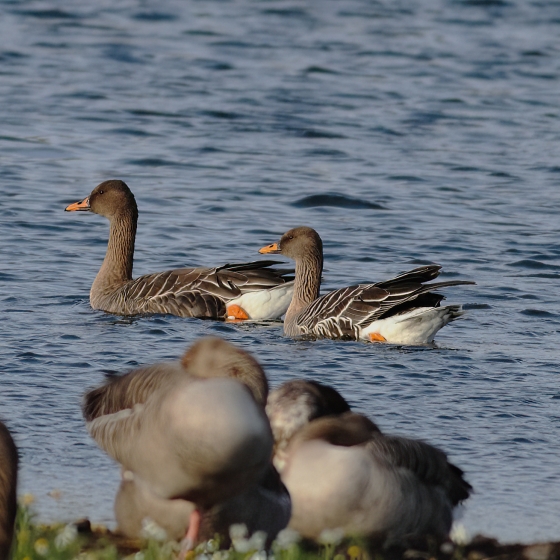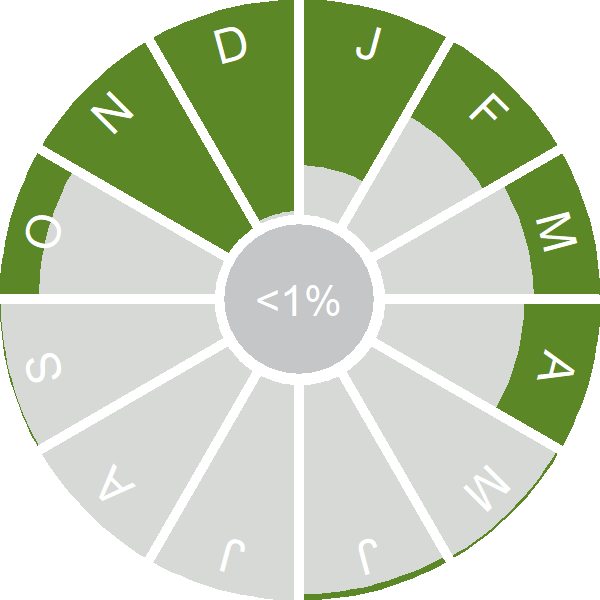Taiga Bean Goose

Introduction
Taiga Bean Goose is a winter visitor to the UK, arriving as late as late November and often departing during February.
The Taiga Bean Geese wintering in the UK use two main sites, one on the Slamannan Plateau in Stirlingshire, Scotland, and the other in the Yare Valley in East Anglia.
Individuals wintering in the UK, which probably number 200–300, are thought to come from the Lapland breeding population. Wetland Bird Survey data demonstrate how numbers fluctuate, with harsh conditions on the Continent sometimes resulting in an influx into the UK.

Key Stats
Identification
ID Videos
This section features BTO training videos headlining this species, or featuring it as a potential confusion species.
Grey Geese (Revisited)
Songs and Calls
Call:
Status and Trends
Conservation Status
Population Size
Population Change
Bean Goose was split into two distinct species - Tundra Bean Goose and Taiga Bean Goose - in 2017. Taiga Bean Geese winter in the UK, but are only found at two locations: on the Slamannan Plateau in Central Scotland and the Yare Valley in East Anglia. The latter population has dwindled to just a few individuals over the past 35 years. The Scottish population has been intensely monitored since the late 1980s when they were discovered Frost et al. 2021. Results from this monitoring show that after a 15 year increase in numbers, this population has shown a slight decline since the mid 2000s. The population is also spending less time in the UK, with most birds now leaving by early February.
Distribution
Taiga Bean Goose is a localised and declining winter visitor. The main wintering strongholds are the Yare Valley, Norfolk and on the Slammanan Plateau, Stirlingshire. Elsewhere, small groups occur at coastal and inland sites and may move around within a winter.
Occupied 10-km squares in UK
or view it on Bird Atlas Mapstore.
or view it on Bird Atlas Mapstore.
European Distribution Map
Distribution Change
Taiga Bean Goose has only recently been recognised as a full species meaning we cannot measure of map changes in distribution.
Seasonality
Taiga Bean Goose is a very localised, and declining, winter visitor.
Weekly pattern of occurrence
The graph shows when the species is present in the UK, with taller bars indicating a higher likelihood of encountering the species in appropriate regions and habitats.

Movement
Britain & Ireland movement
European movements
EuroBirdPortal uses birdwatcher's records, such as those logged in BirdTrack to map the flows of birds as they arrive and depart Europe. See maps for this species here.
The Eurasian-African Migration Atlas shows movements of individual birds ringed or recovered in Europe. See maps for this species here.
Biology
Productivity and Nesting
Nesting timing
Egg measurements
Clutch Size
Fledging
Survival and Longevity
Survival is shown as the proportion of birds surviving from one year to the next and is derived from bird ringing data. It can also be used to estimate how long birds typically live.
lifespan
Survival of adults
Classification, names and codes
Classification and Codes
- Order: Anseriformes
- Family: Anatidae
- Scientific name: Anser fabalis
- Authority: Latham, 1787
- BTO 2-letter code: XF
- BTO 5-letter code: TABGO
- Euring code number: 1571
Alternate species names
- Catalan: oca de bec curt
- Czech: husa polní
- Danish: Sædgås
- Dutch: Taigarietgans
- Estonian: rabahani
- Finnish: metsähanhi
- French: Oie des moissons
- Gaelic: Muir-ghèadh
- German: Saatgans
- Hungarian: vetési lúd
- Icelandic: Akurgæs
- Irish: Síolghé
- Italian: Oca granaiola della taiga
- Latvian: sejas zoss
- Lithuanian: želmenine žasis
- Norwegian: Sædgås
- Polish: ges zbozowa
- Portuguese: ganso-campestre
- Slovak: hus siatinná
- Slovenian: njivska gos
- Spanish: Ánsar campestre
- Swedish: tajgasädgås
- Welsh: Gwydd Llafur y Taiga
Research
Causes of Change and Solutions
Causes of change
The Taiga Bean Goose is one of the few declining goose populations in the Western Palearctic. Knowledge of the drivers of the population decline is scarce or lacking, so the exact cause is unknown; however, the potential threats that have been identified include legal and illegal harvest affecting adult survival rates and reproductive rates, human disturbance impacting reproductive rates, and the loss, fragmentation and degredation of suitable habitat due to foresty, development and other human-related factors [Marjakangas et al. 2015]. In the UK, the Yare Valley population decline is thought to be a result of short-stopping caused by climate change [Maciver & Minshull 2021].

